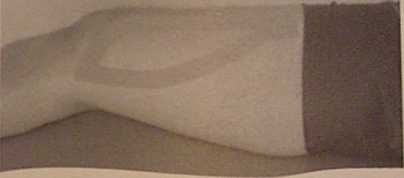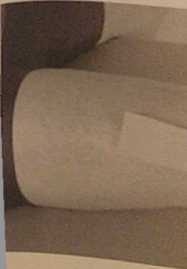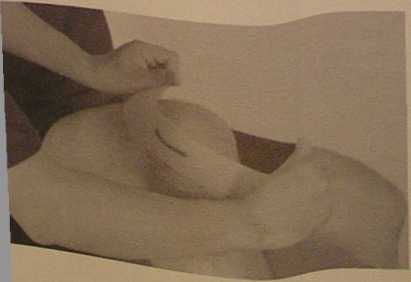P5140088
Piitella Tendinitis - Combination of Kinesio Corrective Tecbniques
Tho practiłioner may decide to combinc components of the three patelia tendonitis techn
examplos will be givcn below. It is important to remember it is the skill and experience of th^^' A l practitioner which guides the s.uccessful use of the Kinesio Technique. 'v
Combination of the U technique and th
ei
strir

Combination of the U strip and the interiory technique.
Combination of the superior Y technicjue and the I strip. It is best to apply the superior Y technique first, this will allow the ends of the Y application to be directly onto the skin to maximize adhesion.

Patelia Tracking Syndrome
,. tracking syndrome is generally thought of as one of the most common conditions of the knce. fi* cauSed by many factors: patelia malalignment, genu varum, genu valgum, genu rccurvatum, patelia balta and weak vastus media lis to name a few. It is a chronię or dcgenerativc fkłtC"J,vn iń which the symptoms of pain and inflammation become morę pronounced with incrcascd
evaluation of the underlying cause of patelia tracking syndrome is critical to the succcss of
uping techniąue applied.
-mUli through the skin reąuiring the surrounding tissues to normalize skin tension. This is accom-•Jhed through the use primarily of mechanical corrective technigues.
The Kinesio Taping Technique assists in reduction of edema and pain by providing aj>roprioceptivc



Optional Muscle Taoine for Weakness Following evaluation the practitioner may deter-mine muscle weakness as a causative factor in the patelia tracking syndrome. For this example the vastus medialis is involved.
For an acute inflamed or oyerused muscle use the insertion to origin application techniąue. For a chronię weakness or weakness resulting from sur-gery use an origin to insertion application techniąue.
This example is demonstrating the origin to insertion techniąue.
Option One: Patelia Tracking Lat<?.ra.l1_y - I Strip
Application of a mechanical correction I strip. As a result of the evaluation of the knee, the practitioner determines where the mechanical corrective strip should be applied.
Begin by placing the patients knee in extension. Tear the paper backing of a 4 - 6 inch long Kinesio I strip in the middle. Holding both ends, apply a mechanical correction, moderate 25-50 % of available tension, with downward pressure on the center of the Kinesio strip over the lateral border of the patelia.
For review see mechanical correction techniąue tension on tails.
The practitioner may either apply the mechanical correction tension while the knee is in extension, or have the patient move into flexion while the Kinesio strip is being applied. By applying the correction while the knee is actively moved into flexion it becomes morę functional.
Apply the mechanical correction tension around the lateral border of the patelia, tension ends as the Kinesio Tex passes the superior and inferior poles of the patelia.
131
Wyszukiwarka
Podobne podstrony:
P5140090 Patella Tendonitis Combination Taping/Bracing The practitioner may desire to use a combinat
P5140055 1Medial and Literał Epicondylitis Combination Taping The practitioner may desire to use a c
P5140080 Hamstring Strain Combination Technique Combination of thc Kinesio Taping Technique and use
P5140008 Properties of Kinesio Tex Tape Skin Preparation Selection of Kinesio Strip Type Kinesio Tex
P5140011 surę are examples of subtle changes mitted from the Kinesio Tex Tape to the superficia
P5140018 Functional CorrectionTendon Correction Application Technigue Use of tendon correction techn
P5140019 Functional Correction Application Technigno Use of functional correction techniąue to assis
P5140020 Lymphatic Correction The lymphatic corrcction is used to assist iii the removal of edema by
P5140037 1 1 .A/hen appr°ximafe,y 1/2 of *e Kinesi^ „ been applied s,lde 1% hand whi.ch ty, sfci W%$
P5140054 Elbow Hyperextension Combination Technique Elbow hyperextension combination taping will com
P5140061 T r the paper backing of the Kinesio I stip in the ‘ M the button holes and apply over eith
EXPERIMENTAL ANALYSIS OF THE CORRECTION FACTOR f expresses the ratio of W / W. Harkins and Brown fou
cp 54 LESSONS THE SAME FOR ALL EOW herc is the simple secret of atiaining correct posturę. Rcad it c
cóś01 VOCABULARY ..What Is the meaning of the underlined words? Circle the ietter
gednap German DNA Profiling SpurenkommissionCertificate of the correct characterization of four stai
P5140062 Lymphedema ol Lymphedema of the upper extremity is the result of edema Ihat 9 " tion.
P5140069 uy down the remaining Kinesio I strip withL S the above steps to form a crisscross patt^ JI
P5140070 Dislocation ofthe PhaJanges of the Fingers Dislocationsof the phalanges occurat a high ratę
P5140099 Knee Hyperextension Combination Techniąue Knee hyperextension combination techniąue will co
więcej podobnych podstron